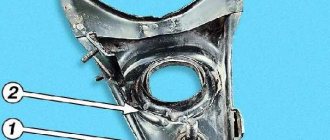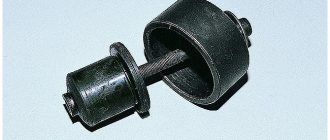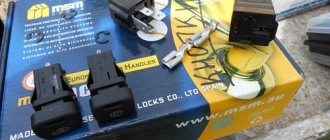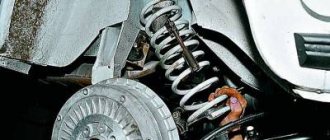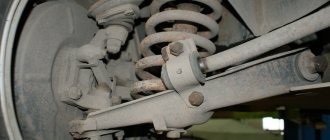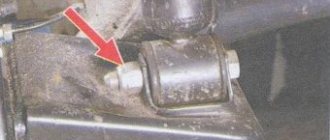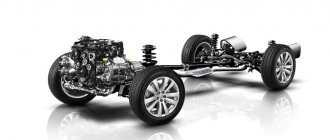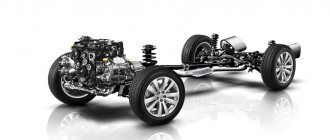How to replace rear silent blocks on a VAZ 2114
Preparatory stage. Initially, the repair site and vehicle are prepared. It is necessary to drive the car onto an overpass or use an inspection hole. It's good to fix it in place and let the car cool down. It is recommended to move away all cables, pipes, and wires passing nearby so as not to damage them during routine repairs of the machine.
It is also important to thoroughly rinse the area where the hinge is located, clean everything from dirt and open access to the fastening system so that nothing interferes and it is possible to replace the rear silent blocks of the VAZ 2114. Fixing stage. The car is installed well, raised on a jack, a place is prepared for repairing the vehicle, wooden blocks are also used to fix some parts of the car
If you are afraid of damaging parts of the brake system and engine, you can dismantle them for a while. Direct replacement of rear silent blocks on a VAZ 2114. Gradually unscrew all the nuts. If necessary, the fasteners that have frozen forever are cut off with a grinder. The metal parts of the hinge are lowered to allow access to the rubber or polyurethane layer. Then, using a chisel and a hammer, the damaged part of the hinge is removed from the niche. A new part is installed in the freed space, which can be clamped in a vice at the time of installation. This is how the replacement of the rear silent blocks of the VAZ 2114 is completed.
It is recommended to carry out a wheel alignment diagnosis at the end of the repair work; this will be more reliable. We observe the behavior of the machine for several days; if the alarming signs disappear, it means that you have discovered the correct location of the problem and fixed it in time. The “stuffing” of a car is complex and consists of small parts, but never discount them. Clearly understand: if it is vital to replace the rear silent blocks on a VAZ 2114, then act, look for opportunities to put the vehicle in order. Transform the powerful “steel horse” into a source of supreme pride! Don't lose sight of a single detail, not a single little thing!
Wheel alignment
How should the silent block be changed? What tools will be needed for this?
But it’s worth starting, perhaps, with the selection of the silent blocks themselves. For models 08, 09 and 099 you need to purchase the specified elements with the following catalog number: 2108-2914054. For versions 10, 12, 14, 15, silent blocks with number 2110-2914054 are suitable. The difference between these structures is in the outer diameter (the difference can be seen in Fig. No. 1a). If you try to install silent blocks from the tenth model on the beam of the “nine” or vice versa, an unpleasant surprise awaits you. It's better not to confuse anything.
Now about the tool. In addition to the traditional set of tools, such as 19mm spanners, a pair of jacks and a hammer, you will need a wooden beam and a device that will help press the silent blocks. You can make this device yourself or buy it. If the purchase cannot take place for some reason, then photo No. 1 shows the main details. Their dimensions are as follows: the diameter of the bolt is 12 mm, its length is 170 mm. The diameter of the ring-clip is 50 mm, height is 40 mm. All other elements of the device are easy to select.
Tips for replacing and operating VAZ 2110 silent blocks
Sometimes, when replacing silent blocks on a VAZ 2110, they try to install a silent block from a VAZ 2109. Despite the external similarity (you can hardly tell the difference by eye), the dimensions of the silent block of the rear beam of a VAZ 2110 are a couple of millimeters larger, therefore the hinge from the “nine” will dangle in the mount. But from the “ten” the rubber bushing, if you try, can be pressed into the VAZ 2109 beam.
- Rear silent blocks must be replaced every 50,000 km, because they are the least durable products compared to other rubber beam bushings.
- Even if one silent block fails, the other one should be changed, because if you replace only the non-working one, the remaining one will “knock” after it, because its resource was already running out.
WHERE ARE THE BUSHING BLOCKS LOCATED?
FRONT ARM BUSHING BLOCKS
In the front suspension, silent blocks are used in the levers; through them, a movable and elastic connection of the levers with the wheel hub and with the car body is carried out. Silent blocks are often used at the junction of the anti-roll bar with the lever, if this is structurally provided for. It can also be used at the bottom of the shock absorber strut, where it is attached to the hub.
In the rear suspension, silent blocks can be installed on levers (longitudinal and transverse), at the point where the torsion beam is attached to the car body, and in shock absorbers.
In general, the number and location of installation of these rubber elements depends on the design of the car's chassis. For example, consider the location of silent blocks on a VAZ-2110 car. And let's start with the front suspension where these joints are used:
- in the transverse arms (at the place of their attachment to the body);
- at the ends of the anti-roll bar (its attachment to the wishbone);
- in the shock absorber struts at the bottom (the place where they are attached to the wishbone);
- in the extension of the transverse lever (at both ends - at the point of its connection with the lever and with the cross member);
We diagnose the condition of silent blocks ourselves
- Machine creaks in the rear left side of the car body while in motion. The driver can increasingly hear a dull creaking sound, as if small and frequent impacts are being made on the rubber. They are especially activated when the car is overloaded and overcomes obstacles on the road, in particular high artificial bumps, or follows paving stones. The so-called “rubber” squeak is also detected at high speeds when performing sharp maneuvers. In such cases, an experienced driver will analyze the situation and think about how to change the front struts on a Passat B3, and what new equipment is worth purchasing. Problems should be diagnosed as soon as possible, because if, in addition to cracks and chips, ruptures appear on the silent block, then it is difficult to predict the behavior of the machine, and repairs will require large financial costs.
- The creaking of a car without a running engine. The most common diagnosis among car enthusiasts is to park the car on a flat surface, go to the trunk and lift the body with your hands, holding the rear left wheel arch. And if you suddenly hear a creak, then one question arises: how to change the silent blocks of the rear beam of the Passat B3, who to turn to for help if you lack knowledge in the field of repairing foreign cars.
- Deterioration in vehicle maneuverability. You notice that the brake pedal has become worse, as if it is falling somewhere, sluggishly responds to the driver’s demands, and sometimes does not work 100%.
- Cracks and chips on the rubber inserts of the silent block. External damage is noticeable only during a visual technical inspection, when the car is on an overpass and there is an opportunity to evaluate everything in the inspection pit. It’s difficult to find, other equipment elements get in the way, but the task is still doable.
Silent block diagnostics
Thus, it is possible to recognize problems in a car if you are vigilant and want to keep your vehicle in good condition at all times. With the help of a specialist or on your own, it’s not difficult to figure out how to change the rear struts on a Passat B3.
Dismantling and installation process
Installation begins after purchasing the parts. You will need a tool - wrenches for removing the beam and suspension arms, a hammer or sledgehammer.
Step by step guide:
The car is driven into a pit or overpass. You can lift the wheel with a jack, but it is so inconvenient to work with the suspension - you have to work lying down. The jack foot should not be in the same plane as the beam bracket. Dismantle the suspension beam. Be sure to remove the handbrake cable when doing this. The brackets have special brackets that hold the brake system hoses. The staples are removed. The old silent block of the beam is dismantled. Garage conditions require the use of a hammer or sledgehammer
You should work carefully so as not to damage the seat, otherwise there will be problems with installing the new part. The seat is cleaned of dirt and graphite lubricant is placed there. Install a new part. Replacement of the silent block of the rear beam is done so that there are no gaps or holes
Pressing is done with careful blows of a hammer. Reassemble the beam in the reverse order.
The replacement is complete and you can drive the car immediately. During assembly, you should check the installation of each part and only then proceed with assembling the next one. The silent block of the front beam is changed according to the same scheme.
Dismantling the old gum is done with 3 - 4 strong blows with a sledgehammer. You should hit strictly in the center of the part, without deviating to the side from the vertical axis. The edge of the clip is bent using a chisel to facilitate dismantling.
Experienced craftsmen use a piece of tube to press out the silent block of the rear beam
It is important that its diameter is slightly smaller than the same parameter of the seat. The tube is placed against the part and hit with a hammer
In a few blows the part will be removed without unnecessary operations.
Reasons for failure of the rear silent blocks of the VAZ 2110
- The rubber of silent blocks, cast with rubber-metal bushings, is capable of absorbing up to 300 kN of load, but if the part turns out to be of poor quality or the hinge is fixed in the wrong position, then its life will be short.
- An aggressive and careless driving style contributes to the destruction of silent block rubber. When braking sharply directly on potholes or when jumping over tram and railway rails, the silent blocks are the first to fail.
- Violation of the wheel alignment angles on a car also leads to the destruction of rubber-metal joints, and as a result, the suspension begins to knock.
- Over time, so-called fatigue cracks begin to appear on silent blocks. They are usually identified by careful inspection of the pillows.
PURPOSE AND DESIGN FEATURES OF THE BUSHING BLOCK
There are one more element in the design - silent blocks. These small-sized parts with a simple design play a fairly important role. Their task is to dampen vibrations and prevent their transmission between the components of the suspension. They are connecting elements of the structure; connections of a number of parts are made only through silent blocks. That is, these parts are directly involved in the main task of the suspension.
Silent block refers to rubber products used in the construction of a car. At the same time, it is a consumable material, which, as a result of wear and tear, is simply replaced, since it cannot be repaired.
The design of this part is very simple and includes only two main components:
- metal clips;
- and a rubber spacer between them.
Outwardly, it looks like a massive bushing that fits into a special seat in the suspension element, but in essence it is just an elastic hinge that connects the parts into one unit. Thanks to the hole in the inner frame, the element in which it is installed to another component of the suspension or body is fastened.
There are also silent blocks, in which only the internal clip is used in the design, and the role of the external one is played by the seat itself in the suspension element.
Replacement
To replace you will need:
- New rear silent blocks;
- A small wooden beam;
- A device for pressing in a silent block (you can do the job without it);
- Open-end wrenches;
- Socket wrenches;
- Spanners;
- Hammer.
Dismantling works
When everything is ready, you can start working.
- Place the car on a level surface in the garage above a pit or overpass. Be sure to place wheel chocks and shoes under the wheels. All for your safety.
- It is better to remove the rear wheel to make it easier to work.
- But it is not at all necessary to remove the rear beam. Just complicate your work with unnecessary dismantling processes.
- On the left side of the driver is the pressure regulator rod for the rear brakes. It will disturb you while you work, so we advise you to remove it. This is done by removing the locking bracket of the rod and the handbrake cable. You will remove the latter from the right side from the mount.
- Unscrew the nut from the bolt with a 12mm wrench that holds the rear beam to the bracket. This may cause problems. Place a socket wrench on the driver to increase leverage on the fastener. Remove the bolt, lift the car with a jack and move the beam down. It will come out of the eyelet this way. Do not overdo it to avoid damaging the nearby brake hose. If you press too hard on the pry bar while moving the eye, you risk breaking the hose.
- Take a pre-prepared wooden block and insert it between the body and the beam. This must be done so that the beam is below the eye.
- Using a hammer and a drift (regular metal tubing will do), knock out the old worn bushings. By the way, if you come across such a concept as “fungi”, don’t worry. This is what car enthusiasts often call these bushings because of their external similarity.
- Clean the seat from accumulated dirt and rust. Be sure to lubricate the areas with soapy water. Without it, it will be difficult to press in new silent blocks. Or use a simple dish detergent. Under no circumstances should you lubricate the seats with grease or oil, as these substances will soon begin to corrode the element.
- Now it presses in new elements. Ideally, you should have a special pressing tool. If you don't have one, use a regular hammer.
- Take out a wooden block.
- Armed with a second jack, lift the beam and insert the mounting bolt into place and tighten it with a nut.
- Reinstall the rear wheel and lower the car to the ground.
Only upon completion of all these stages can the bolts of the new silent blocks be tightened until they stop.
Such an operation should not cause any special problems, so it is not at all necessary to go to a service station and spend extra money.
A car in proper technical condition is the pride of an experienced motorist. Planned repairs and technical inspections are carried out with enviable regularity, the smallest details are not overlooked, and if it is necessary to replace the rear silent blocks of a VAZ 2114, then it is carried out immediately without fail.
POLYURETHANE OR RUBBER BUSHING BLOCKS, WHICH IS BETTER?
If the car has rubber bushings and silent blocks in the suspension, which can be replaced with polyurethane parts, then you will only improve the characteristics of the suspension and its operation. Polyurethane silent blocks will last at least 5 times longer than rubber parts.
Polyurethane silent blocks improve the car's behavior on the road, reducing unwanted deformations in the suspension and eliminating the “squeezing” effect typical of rubber parts. This means that the suspension always operates in the mode intended by the designers.
If you want to improve handling, polyurethane silent blocks are what you need. If you calmly move from one point to another, then choose ordinary silent blocks.
Rear suspension
Sometimes it is also necessary to replace the silent blocks on the rear suspension of a VAZ 2114 car. They are not as susceptible to wear as in the case of the front control arms, but the fact remains.
The sequence of your work in this situation will be as follows:
- If there is no lift, slightly loosen the bolts on the wheels, install a jack, raise the car and completely remove the wheel.
- It is advisable to place some supports under the beam. Both simple bricks and a second jack will do. It all depends on what you have at your disposal.
- Now you need to remove the bolts that are attached to the shock absorber and the car body.
- Proceed carefully to avoid damaging the threads.
- The bolts are knocked out, the beam moves down or slightly back. This will allow you to get to the desired silent blocks.
- They are dismantled with a puller.
- New suspension elements are installed in a similar way to the silent blocks of the front control arms. To help them sit in their nests better, use a soapy solution.
- Reassemble the entire disassembled structure in reverse order.
- During the disassembly and assembly process, pay attention to the remaining components to which you gain full or partial access.
- As practice shows, performing certain repairs allows you to study the condition of related components, assemblies and parts of the car, identify emerging problems in a timely manner and eliminate these breakdowns or what may lead to this.
Should you try it if you have no experience at all? Most likely not. But this experience must come from somewhere, right?!
Choice
Before you start replacing the silent blocks of the rear beam, you need to decide what exactly you will replace the old, worn bushings with.
We figured out the markings and realized that for the VAZ 2109 you need to take only those that are suitable in size and diameter for the rear beam of the nine.
Today, for the VAZ 2109 they offer two types of silents, differing in the material of manufacture.
Size difference
DIY puller
Dismantling and pressing in a new part are difficult stages of work, especially the last one. Therefore, the installation of silent blocks of the rear beam should be performed using a special device - a puller. You can make it yourself or ask a friend. With it you do not need to hit the parts with a hammer, so damage cannot be caused.
Device options:
Small vices. They are put on the suspension part, and a tube is placed under one of the sides
It is important to install the second part so that it presses on the body of the part. But a piece of wood is installed between the vise lip and the part. Homemade device from scrap materials
This option involves turning and welding. Make a clamp from metal plates or improvised means. A hole is drilled in the base, where a nut is usually welded. A bolt is installed here, which serves as a press. Purchase of factory tools.
The option with a vice is the simplest and most reliable. A factory product costs money. If they are not there, but you have the skills and details, then you can make the tool yourself
It is important that it can withstand high loads
Features of elements
The main function of silents is to eliminate vibrations and deformations that occur during vehicle operation.
When choosing new silent blocks for the rear beam of a VAZ 2109, pay attention to the markings. It should be 2109-2914054. For VAZ 2114-15 models, the markings are different, but the elements themselves are very similar.
In principle, it is possible to install a silent block from a dozen on a VAZ 2109, but you will have to work hard with pressing in the rubber bushing due to the difference in size. The reverse procedure is not possible.
Rear beam
Signs of wear on joints
The silent block of the rear beam is a rubber-metal hinge. The part serves as an elastic insert between the car components. It consists of two bushings, between which there is a seal made of rubber or other elastic material. Recently, polyurethane has become widespread. A gasket made of elastic material allows you to dampen vibrations between components and not transfer vibrations to the car body.
The silent block of the rear beam is used not only for connecting suspension units to each other. The element is also attached to the anti-roll bar, at the mounting points of the gearbox and engine of the car. But the suspension has the most severe operating conditions due to dust, dirt, moisture and active movement of parts, so replacement is done regularly.
Rubber bushings are not items that will last forever. Usually they last for 100 thousand kilometers, but due to harsh operating conditions, the replacement period may come earlier. After half this period, it is necessary to check the suspension. This is the only way to understand the degree of wear of the unit and determine whether it needs to be replaced.
Visual inspection procedure:
- drive the car into a pit or lift it with a jack;
- clean the suspension mounting points from dirt;
- carry out an inspection.
The rubber insert must not have cracks or tears. Signs of this kind indicate that it is time to replace the silent blocks of the rear beam. A worn part will subsequently affect handling, and this, in turn, will affect the safety of the car owner and others.
Sometimes the part wears out earlier, especially when driving off-road. The degree of wear can be assessed by the behavior of the car.
Signs of wear on silent blocks:
- when driving in a straight line or when braking, the car pulls to the side;
- increased wear of rubber on the sides;
- increased vibration when driving;
- creaking or knocking in the suspension area;
- the suspension began to work harder.
The presence of one or more signs means that it is time to service the suspension. Delay can be costly. Untimely replacement will lead to loss of control in a critical situation, as well as accelerated tire wear. The hinge seats will also be damaged and then the lever will have to be replaced - this will increase the cost of repairs.
Metal parts of the part break extremely rarely. The rubber gasket usually wears out.
Reasons for premature replacement:
- Long-term use, which leads to drying out of the rubber seal and loss of properties.
- Interaction with chemicals. Oil and gasoline destroy rubber.
- Incorrect installation.
Premature wear indicates that the cause needs to be found and eliminated. Otherwise, the replacement procedure will soon have to be repeated. Oil leaks will be clearly visible, and installation should be carried out strictly according to the instructions and connections should be checked.
In a car, the wheels are attached to the power part of the body using levers. In order for the suspension to smoothly handle all road irregularities, the following conditions must be created:
- The wheel, under the influence of a spring, must move up and down on the lever, so it is screwed to a steel axle rigidly fixed to the spar.
- To absorb small potholes in the road surface at the junction of the chassis and the body, an elastic gasket is needed. Otherwise, the driver and passengers will begin to feel vibration transmitted from the wheels.
Accordingly, silent blocks are needed for a movable and at the same time springy connection between the body part and the entire suspension of the car. They are the same gasket that softens small impacts and allows the lever to work out large irregularities.
On each side, the suspension rests on body elements at 2 or 3 points. In the first case, it is mounted on a lever and a strut, in the second - on two levers and a shock absorber. As many attachment points as there are, so many pairs of silent blocks are used as softening pads.
The second name for a rubber-metal part is a dry hinge. It characterizes the ability of silent blocks to work without lubrication - only due to the elasticity of the insert between two steel bushings. At the same time, the turning radius of the lever is limited by the ability of the rubber or polymer to twist. But for the working stroke of a car suspension, this radius is quite enough.
Now about the specific points where dry hinges are located:
- The main place mentioned above is the attachment of the upper and lower arms. The strength element of the body - the spar (standing under the wheel arch) has a protrusion with a hole into which the axle is inserted in the form of a long bolt. Rubber-metal hinges, pressed into the eyelets of the lever, are placed at the edges of the axle and secured with nuts.
- The small silent block is located at the lower point of attachment of the strut to the steering knuckle.
- On shock absorbers, the hinges are placed on both eyes - top and bottom.
- Parts are also used at the support points of torque rods and anti-roll bars.
DETAILS: Replacing brake fluid and bleeding the ABS modulator Lexus RX300
The rear suspension of modern cars most often has a multi-link or torsion bar design. In both cases, levers mounted on silent blocks are involved. So hinges are used not only in the front suspension. Even on cars with a continuous rear axle beam, rubber-metal products are used to install rear linkages and shock absorbers.
The silent block is considered a fairly reliable part of the car's chassis. Lever joints last from 50 to 150 thousand km, depending on driving conditions and the condition of roads in a particular area. On jet rods, these parts serve no less, but on shock absorbers, struts and anti-roll bar they last up to 50 thousand km.
Silent blocks have one unpleasant feature - it is quite difficult for an ignorant motorist to diagnose their malfunction as a result of wear. You should have an inspection ditch, a tool, and most importantly, practical skills at your disposal. To detect play on a lever or strut, you need to know exactly how to hang the wheel and where in the car to place the pry bar in order to swing this or that suspension element.
There are a number of signs that indirectly indicate worn dry joints:
- a dull, quiet knock when driving over small potholes;
- dull knocks coming from one side when making a sharp turn indicate problems with the stabilizer joints;
- the car deviates from a straight line on a flat area, lateral wear is visible on the tires;
- deep cracks in the rubber filler or misalignment of the lever, detected during a visual inspection from the pit.
The listed symptoms cannot directly indicate the non-working condition of the silent blocks, unless the rubber began to fall out in pieces and the wheels were noticeably warped. Ball joints and tie rod pins can produce dull knocks, while products with cracks in the rubber may turn out to be quite serviceable.
Tools and materials
Tools you will need:
- Spanners (take a full set at once);
- Socket wrenches;
- Vise;
- Chisel;
- Hammer;
- Puller;
- Silent blocks.
There are several important nuances:
- to take silent blocks from repair kits intended for models 2108-2112 . You will simply waste your money because they are not suitable for the fourteenth VAZ model.
- The easiest way to purchase a puller is at auto parts stores. But you can ask your friends for it.
- You can make a device for pressing in a new silent block yourself. To do this you will need a 170mm M12 bolt, a bushing, a washer and a high nut. But if you have the opportunity to use a full-fledged, real tool, do just that.
What is a silent block?
A silent block is a small part made of polyurethane or rubber; the kit includes two metal bushings. In other words, a silent block is a rubber-metal hinge that performs connecting and protective functions. It is used to complete parts of the front and rear suspension and gearbox. And if the rear silent blocks of a VAZ 2114 are replaced, then new ones of the appropriate brand and size of the product are purchased. Under no circumstances should you make any substitutions; every millimeter is important in the configuration of the machine.
Silent block VAZ

